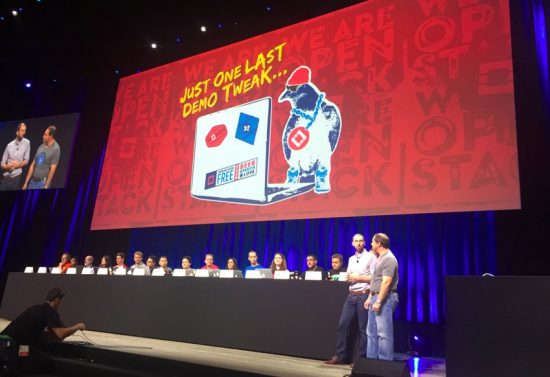The OpenStack Summit is a place to learn and collaborate, discuss and inspire, all in four days every six months. Keynote talks for the first day reflected the international blend of both the operators and users of OpenStack. Our Cisco team agreed that we like the overall message, which feels like, “Here is how we’ve changed the world,” rather than a call to change the world. Not that it felt like a done-deal, but that it provides a proud showcase of the feats of a world-wide cloud community. OpenStack community members have created a cloud for the planet, and the members of our planet are doing amazing work with it.
In addition to user stories, day one gives us the results of the SuperUser Awards, where teams apply and showcase their OpenStack deployments. Spoiler alert, the winner is China Mobile! As noted in the SuperUser article, “China Mobile is the world’s largest mobile phone operator with an eye-popping 835 million subscribers.” Wow. Notably, there were 12 nominees, from enterprise workloads to service providers to research or government to telecom.
For many of today’s speakers, OpenStack enables their scientific research. Oh, the science! Time and time again a speaker talked about their massive cloud updates, such as CERN adding 100,000 cores in the next six months. And from Cambridge University, Dr. Rosie Bolton described the world’s largest radio observatory and its data use. Their instruments ingest 400 Gbyte per second, distribute 400 million tasks, then generate and destroy 1.3 ZettaBytes of intermediate data products on the way to preserving and shipping 1 PetaByte per day of scientific data products. One quadrillion bytes of data thanks to a Square Kilometer Array (SKA) telescope pointed to the sky. We can learn so much here.

Image Credit: CSIRO.
Day two of the Summit brings me to an early morning breakfast with the Women of OpenStack, led by Jessica Murillo, Vice President, Strategy at IBM Systems. We’ve gathered together before the keynotes for about three years now. We heard two lightning talks.
First was Nithaya Ruff, Director of Western Digital Open Source and CTO Office talked about using OpenStack contribution analytics to improve diversity. Bitergia collected and presented data at the last summit, and it is very helpful to track metrics because: what we measure, we do. Sharing the report sparks conversations about how to improve, what areas to focus in, and which projects and programs are helping improve the numbers.
Next was Holly Basemore, Director of Elastic Cloud at Comcast. She talked about what it means to network with others. Don’t push an agenda about what you’re working on, rather connect in a meaningful way and find out about their passions and interests. After you meet people, reach out in a timely manner to make sure the connection and memory is fresh.
We are all so proud of the many women representing OpenStack developers and users on stage for both days of keynotes. We also saw an impressive demo of interoperability and OpenStack clouds including Cisco Metacloud, represented by Rohit Agarwalla, second from the left.

Sixteen Interoperable Cloud Orchestration Demonstration at OpenStack Summit Barcelona, 2016.
Image Credit: OpenStack.
Sixteen cloud demos represented on stage, all orchestrating deployment of a Linux, Apache, MySQL, PHP (LAMP) stack running a WordPress instance. As expected in open source projects, you can get the source code and run it yourself. This image shows the good nature of both busy people and vendors collaborating together to make this happen on stage. And the nature of the OpenStack Summit is what sticks with me as I continue to work with these collaborators and contributors each day.
CONNECT WITH US